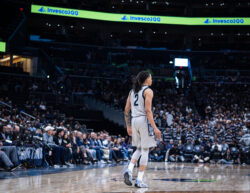Despite visions of pink satin and perfumed tutus, the smell of stale sweat usually associated with wrestling mats and tavern regulars that assails you as you step into the New South Dance Studio is alarming. In the Georgetown University Dance Company, rows of lithe and leotarded dancers swaying to the strains of classical music seem to exist in an oasis of effortless and demure grace.

Unlike most sports, which require intensive cardiovascular endurance, dancers must rely on core strength and isometric training; underneath their flashy tights is lean muscle and steely sinew. Greg Wood, a trainer working in the varsity weight room at Yates Field House extols dancers’ ability to stabilize their body and to control their movements gracefully. In his experience as a trainer, Wood has helped to instruct cheerleaders, not quite the ballerinas of ‘Swan Lake’ fame, but in the same vein of athletic pursuit. The women he worked with followed a lifting program as encompassing as any other team sport.
“I do a lot of arms, you need to be toned. You can’t have flabby arms in ballet,” Morales said.
GUDC Faculty Artistic Director Miya Hasaka is a force of constant motion in this room. Baggy yoga pants and a loose white shirt enfold her petite frame as she strides across the room to change the music or moves quickly to the front of the class to demonstrate the next step sequence for her dancers. Hisaka’s clapping and intense voice accompany them as they move in synchronized motion, down to the lyrical expression of their fingers.
Aside from the filmy skirts and lacy tank tops, many of the dancers could pass for track stars. With their muscular legs and sculpted shoulders, they are physical manifestations of the athleticism required for dance. This physique does not come without considerable effort, according to senior Laura Morales, GUDC’s production director and a dancer in the company.
In addition to rehearsal, which can take up as much as ten hours a week, Morales says that she tries to make it to the gym at least once or twice. When asked whether the club’s pursuits should be viewed as athletic, Morales answered that, “GUDC is not a sport, GUDC is performing arts, but it deserves the same respect as a sport.”
The culmination of all the dancers’ work comes at the end of the semester at GUDC’s show, which will take place this spring on April 13 and 14. Company members perform pieces from different genres of dance, including hip-hop, jazz and modern; ballet is certainly not the only meritous form of expression for the women who make up the company. Morales even proclaims, “I don’t like ballet” but accedes that it is part of a well-rounded dance background. She prefers hip-hop and attends a class at Dupont Circle to get extra practice in.
“We’d do a lot of stuff focusing on stabilization, doing stuff with eyes closed, single-leg squat, dead lift.”
Many mainstream athletes utilize dance as a method of cross-training. Hisaka herself used to teach dance conditioning and stretch for the Syracuse University basketball team and says “it really helped their work a lot.” Though GUDC has no male members (a few have tried out for a spot but not met the requirements) Morales says “we’d enjoy having a football player in class, it would be great for them to see the reverse of football, we have to control our muscles” referring to football’s emphasis on brute strength and dance’s focus on deliberate, steady movement.
Greg Wood agrees that dance is a great way to train the body and says that it would be a great outlet for athletes if they “can get over the embarrassing part of wearing tights.”




